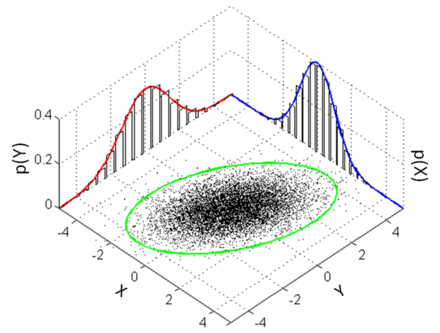
The Gaussian Integral is a famous integral popularized by Carl Friedrich Gauss when he published various computations and variations of the integral in 1809. It is described as the integral of the Gaussian Function over the entire real line. Its applications are also surprisingly broad:
“The integral has a wide range of applications. For example, with a slight change of variables it is used to compute the normalizing constant of the normal distribution. The same integral with finite limits is closely related to both the error function and the cumulative distribution function of the normal distribution. In physics this type of integral appears frequently, for example, in quantum mechanics, to find the probability density of the ground state of the harmonic oscillator. This integral is also used in the path integral formulation, to find the propagator of the harmonic oscillator, and in statistical mechanics, to find its partition function” (Wikipedia).
The integral is given by: ∫{-∞,∞} e-(x^2)dx
To solve it using iterated integrals, let: ∫{-∞,∞} e-(x^2)dx = ((∫{-∞,∞} e-(x^2)dx)2)(1/2)
Because we are dealing with definite integrals, we can split the square of the integral into two identical integrals with respect to different dummy variables: ∫{-∞,∞} e-(x^2)dx = ((∫{-∞,∞} e-(x^2)dx)(∫{-∞,∞} e-(y^2)dy)(1/2)
Since the bounds of the integrals are constants and the integrands are both functions of only the concerned variable, we can rewrite the product of the two integrals as a single iterated integral: ∫{-∞,∞} e-(x^2)dx = ((∫∫{-∞,∞}{-∞,∞} e-(x^2)-(y^2)dydx))(1/2)
Doing polar substitution: (x ∈ {-∞,∞} ∧ y ∈ {-∞,∞}) ⇔ (r ∈ {0,∞} ∧ θ ∈ {0,2π})
And: e-(x^2)-(y^2)dydx ⇔ e-r^2rdrdθ
Which yields: ∫{-∞,∞} e-(x^2)dx = ((∫∫{0,2π}{0,∞} e-r^2rdrdθ))(1/2)
Doing a u-substitution with: u = -r^2 ⇒ du = -2r, gives us: ∫{-∞,∞} e-(x^2)dx = (((-1/2)∫∫{0,2π}{0,-∞} eududθ))(1/2)
Which simplifies to: ∫{-∞,∞} e-(x^2)dx = ((-1/2)(∫{0,2π}dθ)(∫{0,-∞} eudu))(1/2)
Evaluating these basic integrals, we finally have: ∫{-∞,∞} e-(x^2)dx = π(1/2).












